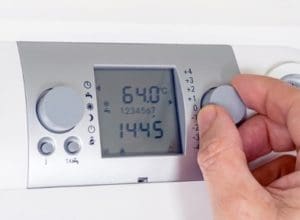
You don’t need the same knowledge as an air conditioner (AC) technician to use your AC. However, some basic knowledge of an AC system will help you run it efficiently. Below are three parts of your AC that you should know well.
Thermostats
The thermostat is a temperature sensor. The thermostat senses the temperature and sends the signal to the AC’s mainboard for the necessary adjustments. Thermostats come in two main types.
1. Mechanical Thermostats
Mechanical thermostats require physical setup and tuning. They are relatively inexpensive but not as accurate as other thermostats.
2. Electronic Thermostats
Electronic thermostats use digital controls instead of mechanical controls. They are relatively expensive but efficient. Electronic thermostats come in various types, such as:
- Programmable thermostats that allow scheduling of future temperature settings
- Non-programmable thermostats that don’t accept future scheduling
- Smart thermostats that connect to the internet for remote control
You should also know:
- How to set the temperature
- How to program the thermostat, if it’s programmable
- How to access the thermostat remotely, if it’s smart
Whichever thermostat you choose, you should have no trouble using it for efficient temperature control.
2. Filter
The air filter traps particles in the return air. That way, the contaminants don’t clog the AC, and you don’t breathe in polluted air. ACs use different types of air filters, such as:
- Washable filters and non-washable filters
- Media filters that use physical materials to trap pollutants and electrostatic filters that use static electricity to trap pollutants
- High-efficiency particulate air (HEPA) that trap more pollutants than other types of filters
Below are the main things you should know about filters.
Type
You should know the type of filter you have so you can know whether to replace or wash the filter once it’s dirty. You also need the knowledge to buy the right replacement filter. You should find the information on the actual filter.
Efficiency
The filter’s efficiency refers to the size of pollutants it can remove. The Minimum Efficiency Reporting Values (MERV), which refers to a filter’s efficiency, range from 1 to 20. The higher numbers indicate higher efficiency. According to bobvilla.com, residential homes work well with filters of MERV 13.
Location
You should know your filter’s location so that you can easily change it whenever it’s dirty. The typical location is the return air (intake) side of the air handler. You may also find the filter behind the return grill if your house has a return channel on every room.
3. Damper
Air dampers, which sit inside air ducts, open and close to control the volume of air circulating in your house at any time. The dampers allow independent temperature control of different rooms. Say you want more cooling in the kitchen than in the bedroom; you can open the kitchen dampers to increase cool air delivery.
You can use mechanical or automatic dampers. The mechanical variety requires manual operations – you have to physically open and close them. These dampers are not as relatively inconvenient and inefficient. Automatic dampers have motors that open and close the dampers automatically with feedback from the thermostat.
Look for manual dampers in accessible parts of the ductwork. The location makes sense since you must reach them for easy balancing of airflow. You can also find manual dampers near the AC. You don’t have to locate automatic dampers (that sit inside ductworks) since you don’t need to operate them manually.
Hopefully, the knowledge above can help you use your AC to its best efficiency. Contact Steele Brothers Heating Inc. if you need any AC service. We have been active in the heating and cooling industry since 1993 and will use our experience to give you exceptional service.
